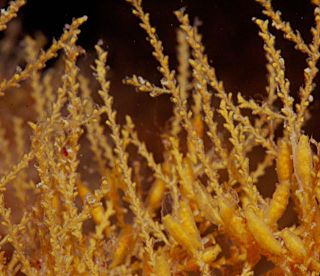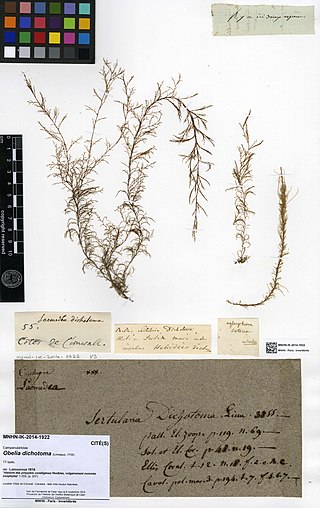
Hydrozoa is a taxonomic class of individually very small, predatory animals, some solitary and some colonial, most of which inhabit saline water. The colonies of the colonial species can be large, and in some cases the specialized individual animals cannot survive outside the colony. A few genera within this class live in freshwater habitats. Hydrozoans are related to jellyfish and corals and belong to the phylum Cnidaria.

Chamaerops is a genus of flowering plants in the family Arecaceae. It contains only one species, Chamaerops humilis, variously called European fan palm or the Mediterranean dwarf palm. It is one of the most cold-hardy palms and is used in landscaping in temperate climates.

Leptothecata, or thecate hydroids, are an order of hydrozoans in the phylum Cnidaria. Their closest living relatives are the athecate hydroids, which are similar enough to have always been considered closely related, and the very apomorphic Siphonophorae, which were placed outside the "Hydroida". Given that there are no firm rules for synonymy for high-ranked taxa, alternative names like Leptomedusa, Thecaphora or Thecata, with or without the ending emended to "-ae", are also often used for Leptothecata.

Eudendrium ramosum, sometimes known as the tree hydroid, is a marine species of cnidaria, a hydroid (Hydrozoa) in the family Eudendriidae of the order Anthoathecata.

Obelia longissima is a colonial species of hydrozoan in the order Leptomedusae. Its hydroid form grows as feathery stems resembling seaweed from a basal stolon. It is found in many temperate and cold seas world-wide but is absent from the tropics.

Hydroids are a life stage for most animals of the class Hydrozoa, small predators related to jellyfish.

The tubular sponge hydroid is a species of hydroid cnidarian. It is a member of the family Tubulariidae. These animals usually grow embedded in sponges.

The grey fan hydroid is a large colonial hydroid in the family Solanderiidae.

Hydractinia altispina, or high-spined commensal hydroid, is a small colonial hydroid in the family Hydractiniidae.

Hydrocorella africana, the shell-mimic hydroid, is a small colonial encrusting hydroid in the family Hydractiniidae.

Thuiaria articulata, the jointed hydroid or sea spleenwort, is a branching colonial hydroid in the family Sertulariidae.

The planar hydroid is a branching colonial hydroid in the family Sertulariidae.

Corhiza scotiae, the fine hydroid, is a delicate colonial hydroid in the family Halopterididae.
Pycnotheca mirabilis, The feathery hydroid, is a colonial hydroid in the family Kirchenpaueriidae. Feathery hydroids are often white and grow in crowded colonies resembling upright feathers. The stems may grow to 3 cm in total height. The reproductive bodies are found at the base of the stems and resemble beehives.

Plumularia setacea, the plumed hydroid or little sea bristle, is a colonial hydrozoan in the family Plumulariidae and is found worldwide. It lives from the shore to 430m under water.

Aglaophenia pluma, the toothed feather hydroid or podded hydroid, is a colonial hydroid in the family Aglaopheniidae and is found worldwide. It lives from the shore to 120m under water.

Macrorhynchia filamentosa, the smoky feather hydroid, is a colonial hydroid in the family Aglaopheniidae.

Albuca humilis is a bulbous flowering plant, placed in the genus Albuca in the subfamily Scilloideae of the family Asparagaceae. It is native to southern Africa – to South Africa from the Free State to KwaZulu-Natal according to some sources, or to the Drakensberg Mountains of Lesotho according to others.

Obelia dichotoma is a broadly distributed, mainly marine but sometimes freshwater, colonial hydrozoan in the order Leptothecata that forms regular branching stems and a distinctive hydrotheca. O. dichotoma can be found in climates from the arctic to the tropics in protected waters such as marches and creeks but not near open coasts like beaches in depths up to 250m. O. dichotoma uses asexual and sexual reproduction and feeds on mainly zooplankton and fecal pellets. Obelia dichotoma has a complex relationship with the ecosystem and many economic systems.
Schuchertinia milleri, commonly known as the Miller hydractinia, hedgehog hydroid or snail fur, is a small colonial hydroid in the family Hydractiniidae, found in the eastern Pacific Ocean. It forms mat-like colonies on rocks, or sometimes on the mollusc shells occupied by hermit crabs.


















